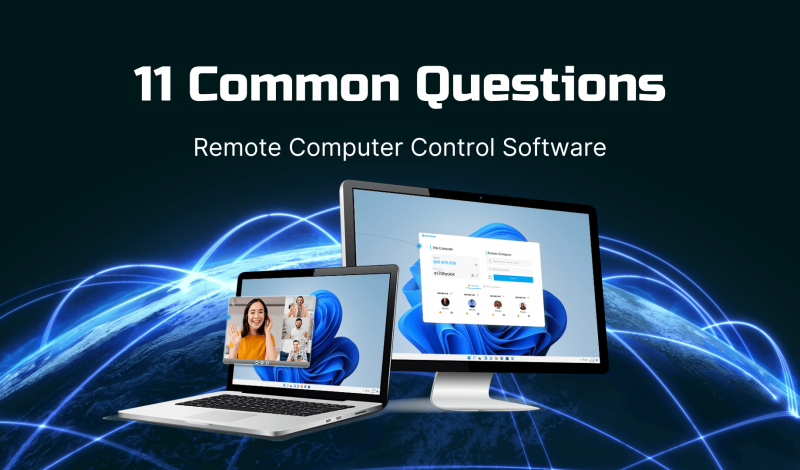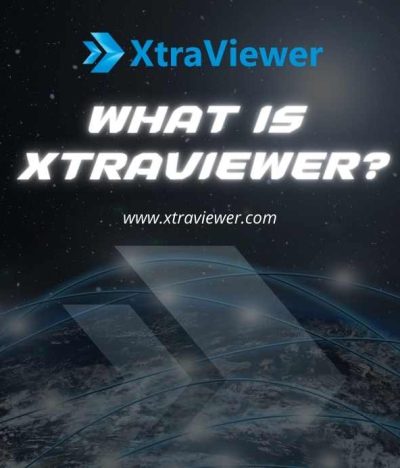In an increasingly interconnected and technology-dependent world, remote computer control has become indispensable for many people. There are several software options on the market that allow remote computer control, such as Splashtop, SupRemo, Iperius Remote, Zoho Assist, GoToMyPC, ManageEngine, LogMeIn Pro, Xtraviewer, AnyDesk, RemotePC, and Remote Utilities. However, XtraViewer has emerged as an exceptionally powerful and versatile application, surpassing them all.
Here, I will answer 10 common questions about remote computer control software. If you have any questions among the ones listed below, please read the entire article for a better understanding or watch the video for a quicker overview.
What is remote computer control software
Remote computer control software refers to tools and applications that enable users to access and manage a computer or device from a remote location, often via the internet or a network. It empowers users to interact with a remote computer as if they were physically present.
These software solutions typically offer features like desktop viewing, mouse and keyboard control, file transfer, and command execution. They find extensive use in technical support, troubleshooting, remote work, and server administration.
These software options come in various forms, including standalone applications, web-based platforms, and integrated protocols such as Remote Desktop Protocol (RDP) or Virtual Network Computing (VNC). To establish remote control and data transfer, users generally install the software on both the local and remote computers and create a connection between them.
What are the most popular remote computer control software and applications available today?
Currently, there are many popular remote computer control software and applications, and XtraViewer is one of the most popular options. Here are some other popular remote computer control software:
1. XtraViewer: XtraViewer is one of the most popular applications for remote computer control. It supports multiple platforms and offers powerful features.
2. TeamViewer: TeamViewer is also a very popular application for remote computer control. It has high speed and supports many useful features.
3. Remote Desktop Protocol (RDP): RDP is a protocol built into Windows that allows you to control a computer remotely. You can use it to connect to computers running Windows.
4. Chrome Remote Desktop: This is a free application that allows you to control your computer remotely using the Chrome browser.
5. AnyDesk: AnyDesk is also another popular choice for remote computer control, with fast speed and high security.
Please note that the features and performance of these software may vary over time and by version. It’s important to choose software based on your specific needs and the features you value, not necessarily relying on a single software.
How can one choose the most suitable remote computer control software to meet their specific needs?
Choosing the most suitable remote computer control software to meet your specific needs requires careful consideration of several factors. Here are steps to help you make an informed decision:
1. Platform compatibility: Ensure the software is compatible with the operating systems of both the set (controlling) computer and the remote (controlled) computer.
2. Security: Make sure the software uses encryption to protect data downloads and provide secure authentication options.
3. Performance and speed: Choose software with fast performance and low response times, especially if you need to perform demanding tasks quickly.
4. File Transfer: Check for secure and efficient file transfer if you need to transfer files between computers.
5. Cost: Evaluate the software’s pricing model and see if it fits your budget.
By carefully assessing your requirements and considering these factors, you can make an informed decision and select the remote computer control software that best suits your specific needs.
Which remote computer control software is highly regarded for its security and data protection features?
A remote computer control software that is highly regarded for its security and data protection features is xtraviewer. This software implements robust encryption protocols to secure data transmission, and it offers advanced authentication mechanisms, including two-factor authentication (2FA) for enhanced security. xtraviewer’s focus on security makes it a popular choice for businesses and individuals who prioritize the protection of their sensitive information during remote sessions.
Is there a way to effectively and efficiently use remote computer control software for free?
Indeed, there are effective and efficient ways to utilize remote computer control software without incurring costs. One notable option is XtraViewer, a reliable and free software as you mentioned. However, it’s essential to be aware that free versions of such software often come with feature limitations compared to their paid counterparts. To use free remote computer control software effectively, it’s crucial to identify your specific requirements and seek out software that aligns with your needs.
How can a secure remote computer control connection be established?
A secure remote computer control connection can be established through several key steps and security measures.
Firstly, both the controlling and controlled computers should use reputable and up-to-date remote control software that prioritizes security.
Secondly, strong authentication methods should be employed, such as complex passwords or, ideally, two-factor authentication (2FA). This ensures that only authorized individuals can access the remote computer.
Thirdly, data encryption should be implemented to protect the information transmitted between the two computers. This encryption should be based on robust cryptographic protocols to safeguard against eavesdropping and data breaches.
Additionally, it’s essential to keep the remote control software and the operating systems of both computers updated with the latest security patches to address any vulnerabilities.
Lastly, regular monitoring and auditing of remote control connections can help detect and respond to any suspicious or unauthorized access attempts promptly. By following these steps, a secure remote computer control connection can be established, minimizing the risk of data breaches and unauthorized access.
In what specific technical and IT support applications is remote computer control software commonly used?
Remote computer control software is commonly used in various technical and IT support applications. Specifically, it is widely employed for tasks such as:
1. Technical Support: IT professionals use it to remotely troubleshoot and resolve technical issues on users’ computers or devices.
2. Server Management: Administrators use it to manage servers located in remote data centers, ensuring their proper operation.
3. Software Updates: Remote control allows IT teams to update software and perform maintenance tasks on remote computers without physical access.
4. Training and Collaboration: It is used for online training sessions and collaborative work, enabling participants to view and control a presenter’s computer.
5. Remote Work: In the context of remote work, employees use it to access their work computers from home or other locations.
6. System Administration: System administrators use remote control to manage and configure systems in different locations from a central location.
7. Monitoring and Surveillance: Remote control can also be used for monitoring and surveillance purposes, such as checking the status of remote devices or security cameras.
These are just a few examples of the many technical and IT support applications where remote computer control software plays a crucial role.
What features within remote computer control software help optimize remote work processes?
Remote computer control software offers several features that help optimize remote work processes. These features include:
1. Desktop Viewing and Control: Users can view and control the remote computer’s desktop as if they were physically present, enabling them to perform tasks seamlessly.
2. File Transfer: The ability to transfer files between the local and remote computers streamlines document sharing and collaboration.
3. Clipboard Sharing: Copying and pasting text or files between the local and remote systems simplifies data transfer.
4. Multi-Monitor Support: Many remote control tools offer multi-monitor support, allowing users to work efficiently with multiple screens.
5. Annotations and Drawing Tools: Some software includes annotation and drawing tools for presentations and collaborative work.
6. Session Recording: Users can record remote sessions for documentation, training, or auditing purposes.
7. Chat and Communication: Built-in chat or voice communication features facilitate real-time communication between users during remote sessions.
8. Multi-Platform Compatibility: Software that works across various operating systems and devices ensures flexibility and accessibility.
9. Performance Optimization: Features like adaptive quality settings help ensure smooth performance even on slower internet connections.
10. Security Features: Robust security measures, such as encryption and authentication, safeguard data during remote sessions.
These features collectively enhance productivity and efficiency in remote work processes, making it easier for individuals and teams to collaborate, troubleshoot issues, and manage tasks regardless of their physical location.
How can continuous and stable remote work through remote computer control software be ensured?
Continuous and stable remote work through remote computer control software can be ensured by implementing the following key strategies:
1. Robust Internet Connection: Maintain a stable and high-speed internet connection to ensure uninterrupted remote access and smooth data transmission.
2. Secure Authentication: Utilize strong authentication methods, such as passwords, two-factor authentication (2FA), or biometrics, to prevent unauthorized access.
3. Regular Software Updates: Keep both the remote control software and the operating systems of the controlling and controlled computers up-to-date with the latest security patches to minimize vulnerabilities.
4. Data Encryption: Enable encryption to protect data during transmission, safeguarding it from potential eavesdropping and security breaches.
5. Network Security: Implement network security measures, such as firewalls and intrusion detection systems, to protect against external threats.
6. Remote Access Policies: Establish clear remote work policies and guidelines for employees, outlining security practices and acceptable usage.
7. Monitoring and Logging: Continuously monitor remote connections and maintain detailed logs for auditing and tracking purposes.
8. Technical Support: Provide technical support to users to troubleshoot any connectivity or software issues promptly.
9. Backup and Recovery: Regularly back up critical data and establish disaster recovery plans to minimize downtime in case of unexpected disruptions.
10. Regular Training: Educate users on secure remote work practices and the proper use of remote control software to reduce the risk of security incidents.
By implementing these measures, organizations and individuals can ensure a continuous and stable remote work environment while minimizing security risks and interruptions.
What are the emerging trends and the future outlook for remote computer control software?
The emerging trends and future outlook for remote computer control software include:
1. Enhanced Security: As remote work continues to grow, there is a heightened focus on security. Future software iterations are likely to incorporate even more robust encryption, multi-factor authentication, and advanced security features to protect against cyber threats.
2. AI and Automation: Expect increased integration of artificial intelligence (AI) and automation to streamline remote support tasks. AI-powered features could help diagnose and resolve issues more efficiently.
3. Cloud-Based Solutions: The shift towards cloud computing is likely to influence remote control software. Cloud-based solutions offer scalability, accessibility, and ease of updates.
4. Cross-Platform Compatibility: Future software will likely emphasize cross-platform compatibility, enabling users to control different devices and operating systems seamlessly.
5. Augmented Reality (AR) and Virtual Reality (VR): AR and VR technologies could be integrated into remote control software, providing immersive remote assistance and troubleshooting experiences.
6. IoT Device Control: As the Internet of Things (IoT) continues to expand, remote control software may include features to manage and control IoT devices remotely.
7. User Experience (UX) Improvements: Future software iterations will likely focus on improving the user experience, making remote control more intuitive and user-friendly.
8. Mobile Integration: Enhanced mobile device integration will cater to the increasing use of smartphones and tablets for remote work and support.
9. Analytics and Reporting: Software may offer advanced analytics and reporting capabilities for monitoring and optimizing remote support processes.
10. Collaboration Features: Enhanced collaboration features, such as real-time document editing and group sessions, may become more prevalent.
These emerging trends reflect the growing importance of remote work and support in today’s digital landscape. Remote computer control software will continue to evolve to meet the needs of an increasingly remote and connected world.















